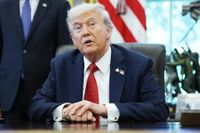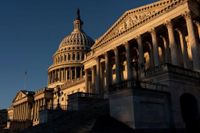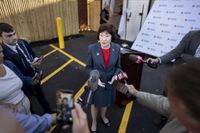As the United States marked the sixth day of a federal government shutdown on October 6, 2025, the nation’s political leaders found themselves locked in a bitter standoff with no immediate end in sight. The impasse, which began at midnight on October 1 after Congress failed to agree on a stopgap funding bill, has left thousands of federal workers in limbo, critical services under threat, and the health care of millions hanging in the balance.
At the heart of the deadlock is a dispute over the future of health care subsidies provided under the Affordable Care Act (ACA), commonly known as Obamacare. Democrats have refused to support a short-term funding patch unless it includes an extension of these subsidies, warning that their expiration at the end of the year would result in sharp premium increases for Americans across the country. Republicans, however, insist that negotiations over health care should only proceed after the government is reopened, and have repeatedly called for a clean continuing resolution to fund federal operations through November 21.
President Donald Trump, who has placed the blame for the shutdown squarely on Congressional Democrats, offered a brief glimmer of hope for a negotiated solution on Monday. Speaking to reporters in the Oval Office, Trump remarked, “We have a negotiation going on right now with the Democrats that could lead to very good things. And I’m talking about good things with regard to health care.” Yet, any optimism was short-lived. Later that day, Trump took to his social media platform to clarify his position, stating, “I am happy to work with the Democrats on their Failed Healthcare Policies, or anything else, but first they must allow our Government to reopen. In fact, they should open our Government tonight!”
The president’s remarks echoed the stance of Republican congressional leaders, who have insisted that the shutdown must end before any substantive talks on health care can occur. White House Press Secretary Karoline Leavitt reinforced this message, telling reporters, “His position is very clear. There’s nothing to negotiate. Just reopen the government. And then we can talk about all the important issues facing our country. So he hasn’t called specific members of Congress. Not to my knowledge, no.”
Meanwhile, Democratic leaders expressed both frustration and readiness to negotiate, provided the White House was genuinely interested in dialogue. Senate Democratic Leader Chuck Schumer stated, “Trump’s claim isn’t true, but if he’s finally ready to work with Democrats, we’ll be at the table.” House Minority Leader Hakeem Jeffries added that Democratic lawmakers were “ready to sit down to work things out,” but noted that the White House “has gone radio silent” since a meeting in the Oval Office the previous week.
Senate Majority Leader John Thune suggested that there could be a path forward on ACA subsidies, but only if the White House was willing to engage. “I think a lot of it would come down to where the White House lands on that,” Thune noted, highlighting the central role of the executive branch in resolving the crisis.
The Senate attempted to break the impasse on October 6 by holding votes on two competing funding measures—one backed by Republicans, the other by Democrats. Neither proposal came close to securing the 60 votes needed to advance, underscoring the depth of the partisan divide. As the House was not expected to be in session for the week, attention shifted to the Senate to take the lead on any potential agreement.
The shutdown’s effects have rippled across the country. Critical food aid programs for women, infants, and children began running low on funds, prompting warnings from lawmakers about the real-world consequences of the stalemate. “Now it’s the American people who are suffering the consequences,” Thune said, emphasizing the urgency of the situation.
For many Democrats, the stakes are particularly high when it comes to health care. Senator Adam Schiff of California, speaking on NBC’s “Meet the Press,” warned that millions of constituents could soon be priced out of their insurance. “In Oceanside and in Anaheim, average families of four are going to see the premiums go up by $900 to $1,000 a month. No one can afford that, and that’s going to happen all across the country,” Schiff said. He argued that the country needs “a president who can act like an adult, who can come to the table, and negotiate an end to their self-imposed health care crisis.”
Yet, not all of the discord is confined to the negotiating table. Disagreements have emerged within the Democratic Party over how best to communicate their position to the public. Some criticized the Democratic National Committee’s use of lighthearted social media posts, including a shutdown explainer featuring cats, as “cringe.” Others questioned the effectiveness of a marathon livestream by House Democrats intended to highlight the shutdown’s impact.
On the Republican side, House Speaker Mike Johnson has been unequivocal in his stance. “There’s nothing for us to negotiate,” he told reporters, urging Democrats to pass the stopgap spending bill that had cleared the House. “We did the job to keep the government open, and now it’s on the Senate Democrats.”
As the shutdown drags on, the economic context has added another layer of complexity. While the U.S. economy has shown resilience—with the stock market hitting fresh highs, buoyed by artificial intelligence news flow—there are growing concerns about the impact of the shutdown. Morgan Stanley strategists have warned that permanent layoffs among federal workers and delays in economic reports could make this shutdown more consequential than those in the past. The Trump administration, for its part, has indicated that if the shutdown continues, it plans to impose permanent job cuts on thousands of government workers, a tactic not previously used in such standoffs. For now, federal employees are furloughed, with the expectation of retroactive pay once the government reopens, but the specter of layoffs looms if the impasse persists.
Despite the robust performance of the stock market—year-to-date gains for the SPDR S&P 500 ETF and Invesco QQQ Trust stood at 15.6% and 19.3% respectively as of October 6—retail traders have expressed caution. Sentiment toward these ETFs on platforms like Stocktwits has turned bearish, even as message volumes remain high, reflecting the underlying anxiety about the broader economic outlook.
Amid the finger-pointing and entrenched positions, one thing remains certain: millions of Americans are caught in the crossfire, facing uncertainty over their paychecks, their health care, and the services they depend on. Whether the current stalemate will give way to compromise—or simply drag on until one side blinks—remains the pressing question in Washington as a new week begins.


